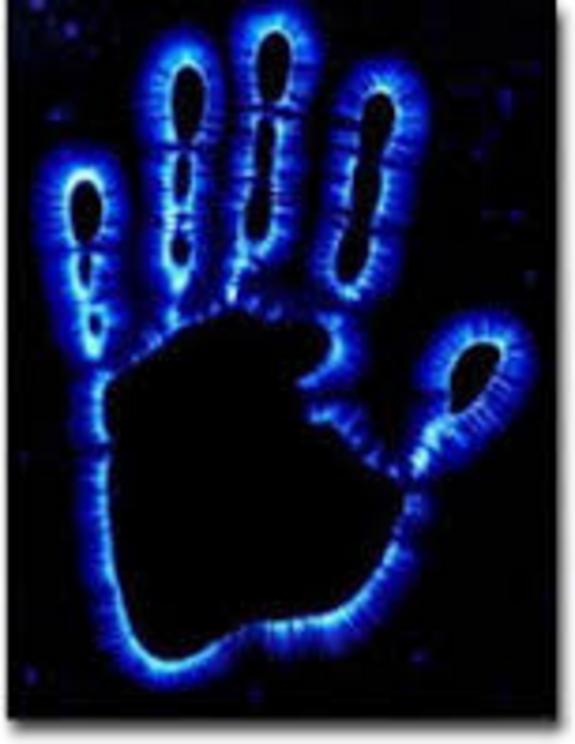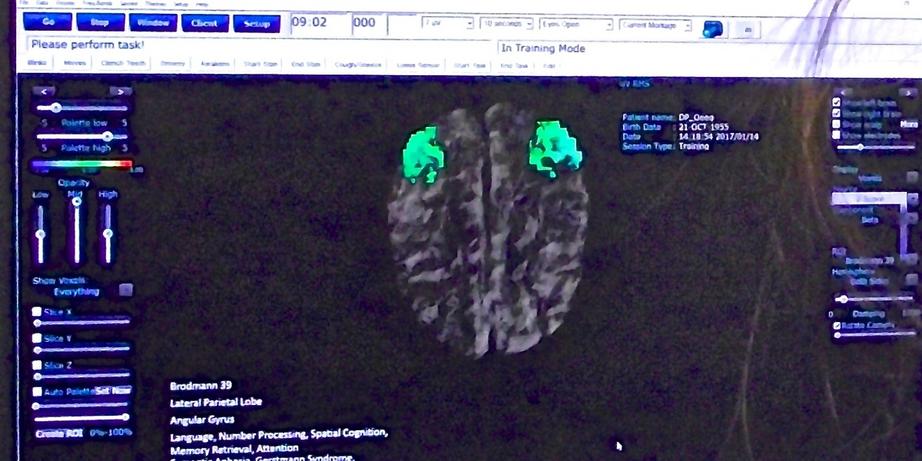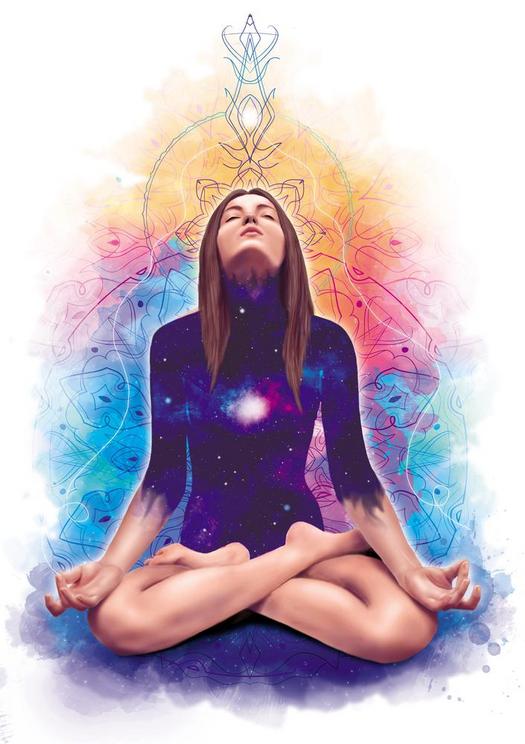Why do some people see auras?
We aren’t just stardust, we literally glow.
One of the most exciting discoveries of this century is that all living cells of plants and animals, including human beings, emit ultra-weak electromagnetic waves in the visible and ultraviolet spectrum, or “bio-photons” (Greek for "life" and "light"). These light particles are generated by biological processes, and each life form has its own unique electromagnetic field, or signature. Research in India suggests this invisible emission may be playing a role in the ability of bacteria, one of the simplest life forms, to detect the presence of a different bacterial species in a sealed test tube several inches away… a communication obviously not chemical in nature.
Bio-photons cannot usually be seen by the naked eye, but can be measured by special equipment, and have been detected by several researchers since the early 1920’s. Biological tissues typically emit approximately one to a thousand photons per square centimeter per second. The health of a living organism influences the amount of light emitted, which means bio-photon measurement might be helpful in medical assessment. For example, typical differences in emission can already discriminate between cancerous and healthy cells.

Sensing electromagnetism in nature
We emit light, but how could someone sense it without special equipment, let alone see it? Evidence of weak electromagnetic fields detection is abundant in nature. Electric fields are directly sensed for location and communication by animals as diverse as sharks, cockroaches, and the duck-billed platypus. The Earth’s magnetic field aids geese and butterflies in their migrations, and is used in navigation by animals as diverse as sea turtles, wolves, and even worms. The first magneto-sensory neuron was actually found in worms, a species no one suspected could sense the Earth's magnetic field. Since then similar sensory cells have been found in other species, including the inner ears of pigeons, a species known for their navigation.
The primary protein receptors for detecting magnetism are called “chryptochromes,” from the Greek for “hidden color.” We have these in our eyes, as do many birds and other animals. Chryptochromes are sensitive to the sky’s blue light, and are believed to play a major role in the magnetic compass of birds, which requires short wavelength (blue/green) light to work. If only red light is present, birds are no longer able to orient.
Drosophila, or fruit flies, also sense magnetic fields using cryptochromes. When placed in an artificial magnetic field, these flies can be trained to head in a specific direction for food. Mutants missing the gene for cryptochromes lacked this ability to find their meal. Their magnetic sense was restored to them by inserting a human version of the gene, but only when they were in the presence of blue light.
In order to understand the role of blue light, we need to look at the quantum level, which has increasingly been evoked to explain mysteries in nature. Electrons in molecules normally associate in pairs. When a cryptochrome is struck by blue light, it transfers one of its electrons to a partner molecule, such that both now have single electrons. When electron pairs are separated by light, they are known as a “radical pair.” In this solo state, their spins are linked, which is known as quantum entanglement. The electrons either spin together or in opposite directions, each of which confers different chemical properties. As a bird navigates, changes in these electronic spins occur in response to their position and angle relative to the Earth’s magnetic field.
If seeing auras is a form of magneto-reception, it implies the photoreceptors and chryptochromes located in our eyes might work together. One possibility is that retinal chryptochromes could make our electromagnetic fields visible by increasing the light-sensitivity of other retinal cells.
What are auras?
Auras are defined by the Oxford Dictionary as “a supposed emanation surrounding the body of a living creature and regarded as an essential part of the individual.” Although auras are a prominent feature of many spiritual traditions, they have become primarily associated with “New Age” thinking. Why some people see them and others don’t has been a mystery, but science is providing some potential answers.
Several researchers have suggested that auras are magnetic in nature, although too weak to attract metal. Every electrical field, such as those generated by our hearts and brains, has a corresponding magnetic field at right angles. This means that magnetic fields are always projecting out from, and around our bodies.
Many autistic children around the globe have spontaneously reported seeing colors around people, consistent with auras, without their ever having had any exposure to this idea. They also attribute meaning to the colors, feeling safer around people with certain colors, particularly violet. One child described people perceived as having red auras as “scary”, and those with brown auras as “rigid.” Each color has a different frequency in the visible electromagnetic spectrum, but how could one’s personality possibly be related?
The first time I heard about the ability to see auras in a scientific context was over twenty years ago when Kathy, a referring psychologist, told me over lunch she was doing her doctoral study with Barbara Bowers, author of “What Color is Your Aura?” The premise of Bowers’ book is that our personality, emotions, interests, and talents are reflected in the color of our auras, which she could see. At the time I was a relatively new arrival to California from Boston. I found it shocking that my level headed colleague could believe such “nonsense.” Kathy explained that she was conducting research to see if Bowers’ work was indeed valid. I agreed to participate, and was even able to get my former husband, a conservative doctor and biochemist, to participate as well.
Bowers claimed she could read someone’s aura in person or from a photograph, because cameras can capture it. We provided Kathy with nondescript photos of ourselves so as to not give away any clues as to who we were. These were given to Bowers by Kathy, without Bowers knowing anything about us, including our names. We then completed the detailed personality questionnaire in her book. After scoring our answers for assignment into one of more than a dozen color types, I read that my personality was consistent with a “green and violet” aura, whereas my husband’s was a “physical tan.”
Each chapter of Bowers’ book is dedicated to describing the attributes of each color. Ours fit us perfectly, but I expected that, because they were based on self-reporting. However, without ever meeting or speaking with Bowers, or showing her our questionnaires, she took one look at our pictures and said my aura was “green with a violet overlay” and my husband’s was a “physical tan.” That grabbed my attention. At the time I had absolutely no context for understanding how this could be.
Seeing auras is considered a form of synesthesia
Perception of colors linked to personality types is considered to be one of over one hundred forms of synesthesia, a condition where one experiences two or more linked senses, such as seeing blue whenever hearing the note “C”. Another form manifests as a consistent linkage between sensory input and symbols, such as seeing red with the number “one” or the letter “H”. Letters for some can be recognized at a glance by their “color.” Calling the ability to see auras a form of synesthesia implies our personalities may similarly fall into orderly archetypical patterns. These archetypes may be immediately recognizable to some people, despite our variety of outward physical appearances. Bowers also claimed to see variation in the relative distribution of aura colors as she traveled through the populations of different countries.
Researchers have suggested we might all experience synesthesia as infants, but in most of us it goes away as our brain circuitry undergoes remodeling in response to our environments. Synesthesia is often inherited, but in many cases it is thought to result from insufficient pruning of neural connections in the angular gyrus, (AG), the evolutionarily newest part of our brain. The AG is involved in language and other forms of symbolic manipulation, and is part of the temporoparietal cortex (TPC). The AG is located on the sides of our brain, slightly above our ears, and strategically placed at the crossroads of all sensory input.

The Quantified Electroencephalogram (qEEG) shown above was set to display only the activity of the angular gyri, which appear as the bright green splotches on top and towards the back of the brain.
We can learn about what a brain area does by looking at what happens when that area is no longer functional, while the rest of the brain is intact. Isolated damage to the left AG can result in Gertsmann’s syndrome: the inability to write, do math, distinguish left from right, or tell one finger from another. When examined closely, many savant skills are the opposite of these deficits. Some savants can do calculations almost instantaneously, others read and write far beyond their chronological age, and some have unusual digital dexterity when playing musical instruments. Like Tammet, many of these autistic savants also attribute their skills in part to synesthesia.
A study at Cambridge University found that synesthesia occurs in 18.9 percent of people with autism spectrum disorder, as compared to 7.2 percent in the general population. Usually our left AG is larger than our right, but in autism the pattern is either reversed or they are the same size. The right TPC has also been reported to be enlarged in autistic brains.
These anatomical findings are consistent with my hypothesis that the right AG is involved not only in synesthesia, but also in savant skills. Synesthesia actually plays a major role in many savant skills, tying the phenomena together, such as in the phenomenal memory of autistic savant Daniel Tammet. He hasn’t had to memorize anything to recite the first 22,000 nonrepeating digits of “pi.” He effortlessly sees them as an unfolding sequence of colored shapes representing each digit sequentially.
Because an enlarged or dominant right angular gyrus and temporo-parietal lobe might be related to savant skills and synesthesia, this might be why some autistic savants see auras when others of us can’t. We emit photons and a weak electromagnetic field, and have magnetic field sensors for unknown reasons in our eyes. People who see auras might not need an enlarged AG. There might be variations from normal in our eyes’ chryptochromes that make some of us more sensitive. But that wouldn’t explain how the color of our “aura” could be linked to personality.
Our brains, hearts, and guts all generate different electromagnetic signals depending upon whether or not we are feeling happy, sad, sleepy, angry, loving, business-like, intellectual stimulated, or some other state. Our heart races when we are excited, angry, or afraid and does the opposite when we are content. Our brain switches frequencies depending upon how deeply we are engaged in thought. Our gut has what has been called a “second brain” because of its neural complexity, and it responds to a variety of emotions, by shutting down or increasing activity.
All three electromagnetic organs are major contributors to our electromagnetic signature as living beings. We are all classifiable by archetypes, or personality types, based upon how we typically respond to our complex environment. For example, some of us are pragmatic thinkers and others are emotional hotheads. Surely, if our composite electromagnetic signatures were made visible, they would be comprised of different frequencies and manifest in a variety of colors. Perhaps seeing auras is simply sensing this.

